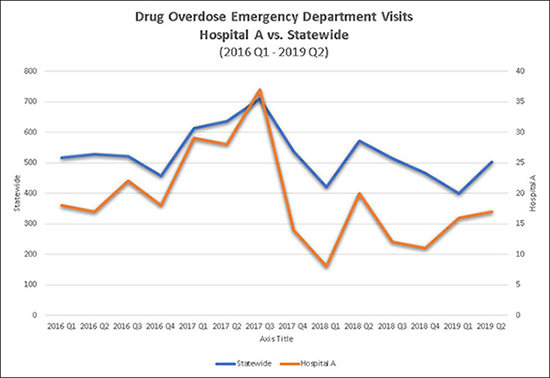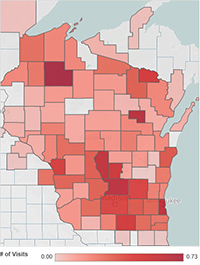Custom Reports / Analytics
If an organization does not want to purchase full data sets, custom data queries can be requested. Queries could include data for specific regions of the state, a select group of hospitals, select ranges of diagnoses and procedures, or specific revenue codes.
For example, a hospital may be interested in the statewide numbers of drug overdoses that result in emergency department visits at Wisconsin hospitals, and how its hospital compares to that data. WHAIC could query the database on selected diagnosis codes for drug overdoses, for each emergency department visit. In the trend lines above, a Hospital is being compared against the statewide totals over three years of data.


In addition to a trend line graph, the custom data could be used to create a heat map. The heat map on the right is displaying where the patients are coming from for the emergency department visits. With this information, hospitals could target and prepare communications for community outreach programs regarding drug overdoses. If you are interested, the mapping could get to even smaller geographic regions.
The next level below Patient County is Patient ZIP codes. Patient ZIP codes have always been available within the data sets. However, WHAIC can also get even more granular in using census block groups. WHAIC began collecting census block groups starting with 2018 Q1 dates of service.
Quality Reporting
In partnership with the Wisconsin Hospital Association, WHA Information Center (WHAIC) has also developed new structured and provider-specific reports that can assist hospitals’ quality improvement activities.
Two initial reports created focus on hospital-acquired infections (HACs) and potentially preventable readmissions (PPRs). Upon request, WHAIC is helping hospitals meet some of the data requirements for the CMS Partners for Patients Project.
Wisconsin DWD Registered Nurse Workforce Data
Aggregate custom reports are also available based on the 2010 and 2012 Registered Nurse Workforce Surveys. Content areas include demographics, formal education, advanced practice nursing, certifications, employment status, career decisions, and current places of employment.